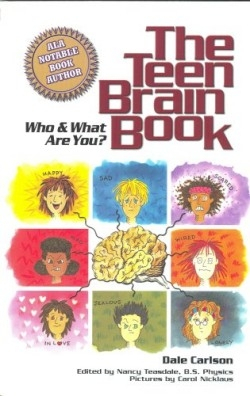The Teen Brain Book
Who & What Are You?
Ask a parent of teenagers to describe their children’s behavior and emotions, and the result will likely begin with “I don’t understand why they do these things!” But, asked the same question, teens may very well say that they don’t understand their own reactions to the world and people around them. The brain changes as kids grow into teenagers, and it can cause a great deal of anxiety for parents and teens as well.
The author sets out to explain and comfort all interested parties in this book, examining the science and psychology of the teen brain. Carlson is the author of more than fifty books, including several teen fiction and nonfiction titles, and she’s the winner of three ALA Notable Book Awards. As a mother and grandmother, she has expertise that isn’t just academic, but rooted in practical experience.
The book is intended to reassure teens about their varying emotions by explaining how the brain works, particularly during the growth period of the teen years. Carlson uses science to explain the “how” and psychology to explain the “why.” Each chapter covers a different aspect of the brain and emotional development, including case studies that illustrate how different emotional responses might occur in different situations. Some of the behaviors may seem routine, such as a teen’s power struggle with her parents, and some are more extreme, like schizophrenia and borderline personality. The book then moves into options for modifying behavior with emphasis on creating a positive, productive life. But Carlson is very clear about who is responsible for change: “Upside: if you don’t like what you are, you can change it. Downside: no one can do this for you, not teachers, parents, therapists, gurus, girlfriends, boyfriends, books … only you can take the torch and light your own fire.”
Carlson has produced an excellent guide to the teen years, one that doesn’t condescend to the reader, but instead appeals to the reader’s intelligence, with its extensive bibliography of sources and scientific explanations. The illustrations, while charming, are somewhat cartoony for its audience of intelligent teens and their parents. But the book’s layout and positive but realistic attitude overcome the shortcomings of the illustrations.
By the time teen readers are finished with this book, they may not completely understand themselves, but they will be far better prepared to learn why they do the things they do and to discover ways to change behaviors and feelings that are destructive. While learning about their brain, they will learn, as the subtitle implies, who and what they are.
Reviewed by
Amy Rea
Disclosure: This article is not an endorsement, but a review. The publisher of this book provided free copies of the book to have their book reviewed by a professional reviewer. No fee was paid by the publisher for this review. Foreword Reviews only recommends books that we love. Foreword Magazine, Inc. is disclosing this in accordance with the Federal Trade Commission’s 16 CFR, Part 255.

